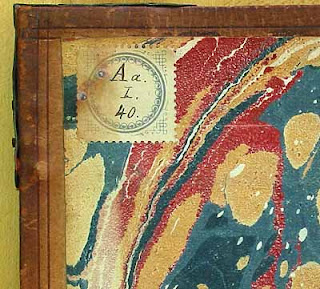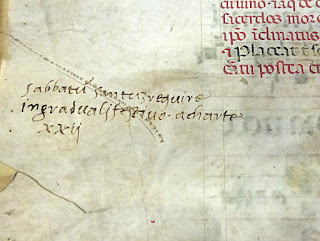A year or two ago, I discovered that Central St Martins, the London college of art and design [Wikipedia], has a collection of medieval illuminated manuscript leaves and cuttings, including quite a number of interest to me. I'll try to write about some of them on another occasion, but today I will describe one of their three bound codices: a characteristically large late medieval Italian choirbook.
The text appears to be unexceptional, but what initially caught my eye is the presence of a blue-edged paper label in the upper left corner of the inner face of the front board:
The three-part form is absolutely typical of shelfmarks, usually indicating the bookcase, the shelf, and the position on the shelf:
 |
| "A. | I. |14." |
In this case it is characteristic of the shelfmark labels used by Howel Wills (d. 1901), in whose library I have long had an interest. He did not use a bookplate, and usually did not write his name in his books, so the label is usually the only way to recognise that he owned a manuscript. Here is another another example, from a webpage that I made in 2002:
And here is another:
Once one has identified a book as coming from his library, it is usually not difficult to find it described in the catalogue of the auction at which they were sold:
 |
| Sotheby's, 11 July 1894 |
In this case, the description of lot 243 is a close match for the the text, number of leaves, decoration, description of the binding, and indication of the size:
There are three main clues to early provenance.
The lower margin of one leaf has what is apparently -- despite its strange placement in the middle of the volume -- a 16th-century ownership inscription:
 |
| "Hic liber est filii de Iacobi Deguntis [or de Guntis?]" |
There is an early shelfmark(?) "U i" (i.e. U 1) at the top of the front flyleaf:
And there is an 18th(?)-century table of contents in Italian, on the verso of the front flyleaf, giving the folio references for the parts of the volume used during Holy Week:
followed by a note referring to another volume presumably in the collection at that time:
"Messa del Giovedi Santo a carte 121.
...
Venerdi santo a carte 138.
Per il Sabbato Santo, altro Libro intitolato Libro Primo."Showing a similar concern for Holy Week is this added note:
"Sabbatum sanctum require
in graduli festivo a charte
xxij"
Returning to the 19th century, the annotated Sotheby's catalogue reveals that the book was bought at the Howel Wills sale in 1894 for £7 10s. by Leighton, doubtless J. & J. Leighton, the London booksellers and binders:
Less than two years later, it was inscribed:
"This books was
presented to the Arts &
Crafts School by
Mr. Ernest Gimson [Wikipedia]
Dec 22 1896"
Presumably as part of the same accessioning process an inventory number "1392" and "London County Council / Technical Education Board" stamp, both printed on paper, were stuck to the centre of the front cover:
Although not a masterpiece of art, the volume is ideally suited to its function as a teaching tool. The binding is original; the sewing is loose enough that the composition of the quires can easily be examined and established; the script and music are large and easily legible; and there is lots of evidence showing how the scribe and decorators worked, such as these guide-letters for the folio numbers, which appear in the outer margin of versos:
 |
| [Click to enlarge] |
 |
| "Fr. v i't." = "F(e)r(ia) V Introit(us)" |
 |
| recto |
 |
| verso |












Very interesting and intriguing, Peter. W. R. Lethaby was the first principal of the Central School of Arts & Crafts and both he and Ernest Gimson were disciples of William Morris; I wonder if Gimson's gift might have been in celebration of Lethaby's appointment in 1896. Morris was himself a buyer at the Wills sale in 1894. He acquired lot nos. 237 (now London, BL MS Egerton 2977) and 1536 (now Notre Dame, IN, University of Notre Dame MS cod. Lat. e.4. Morris's marked copy of the Wills sale catalogue is now at the Grolier Club of New York.
ReplyDeleteBill